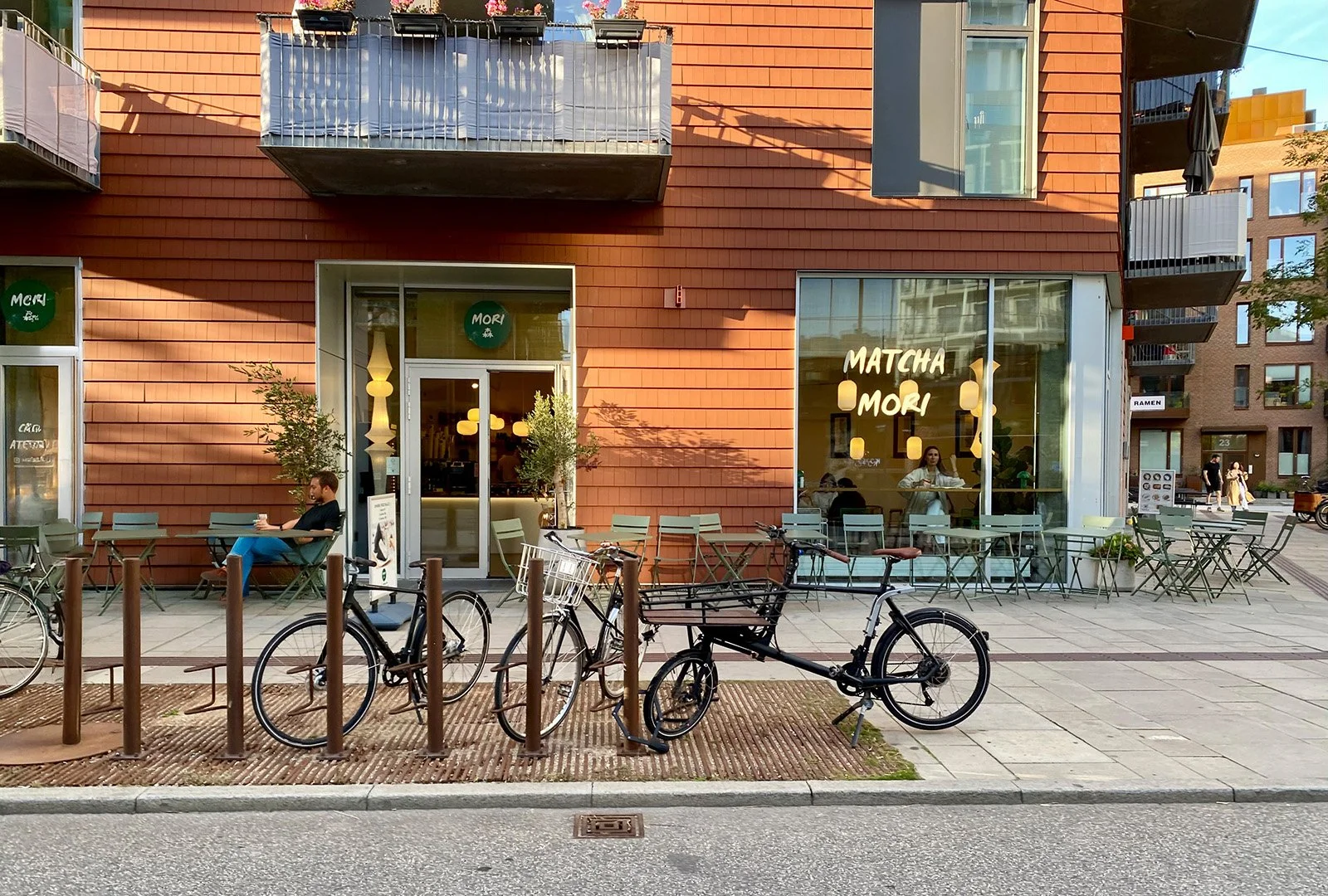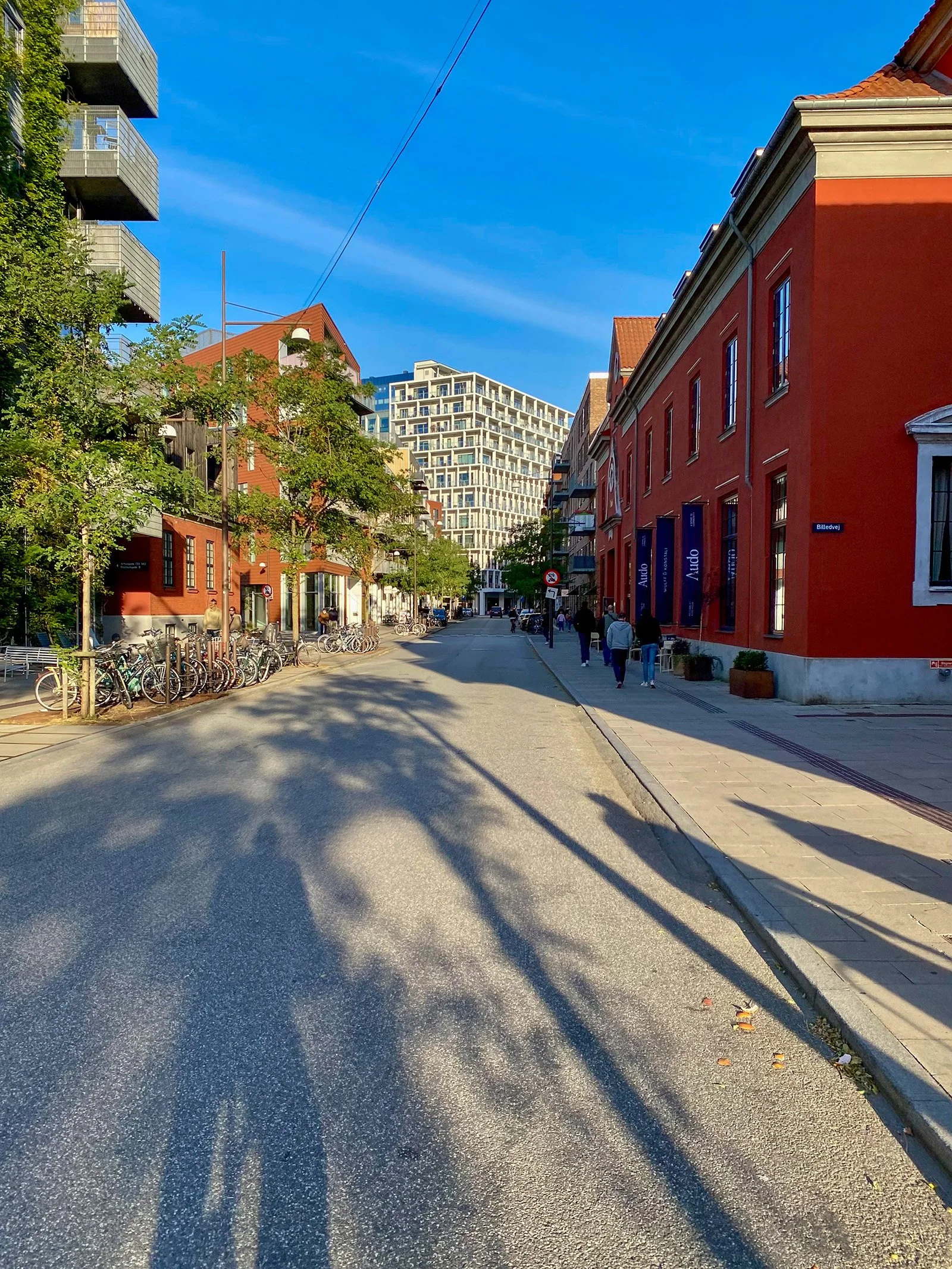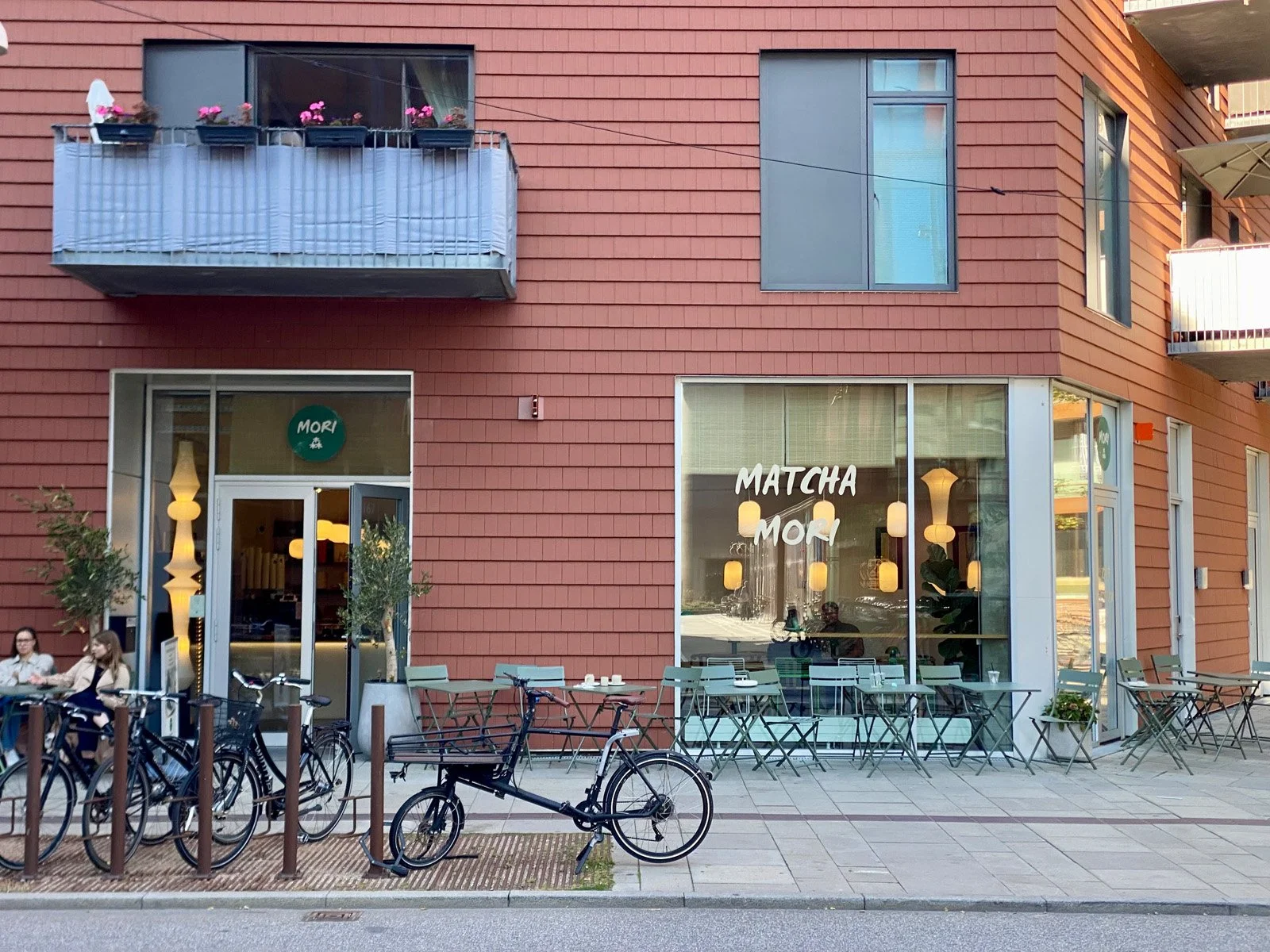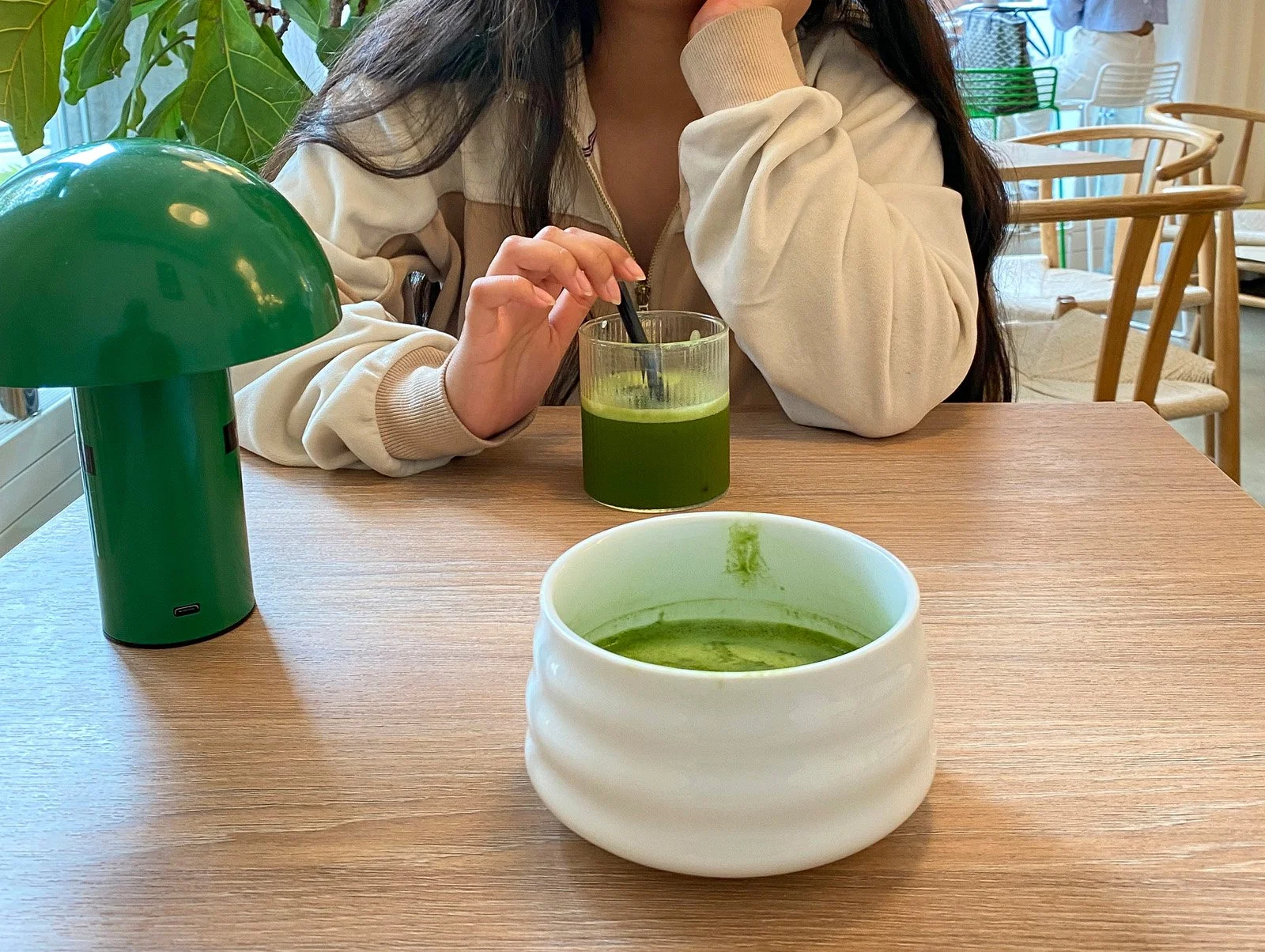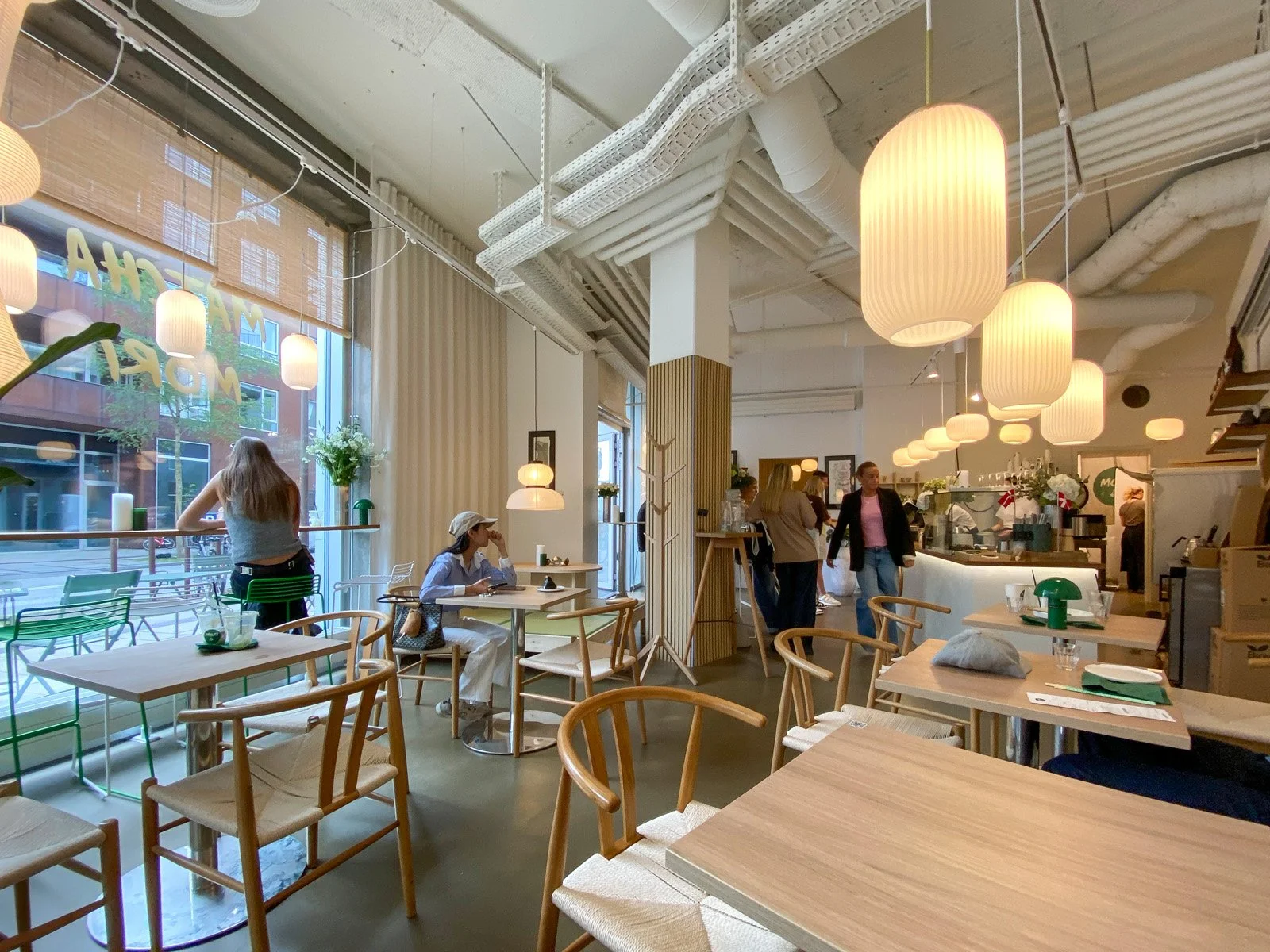MATCHA IN COPENHAGEN
The corner of Århusgade 167 in Copenhagen’s Nordhavn, where MORI Matcha opened in June 2025.
MORI IN NORDHAVN, AND THE QUIET RISE OF A JAPANESE RITUAL
Text by Max
Matcha has travelled a long way from the monastic stillness of Zen temples to the bright fronts of European café culture. In Copenhagen, the clearest expression of this journey sits on a corner in Nordhavn, where MORI Matcha opened its doors in June 2025. This review is based on a visit on 20 September 2025, offering a close look at one of the city’s newest and most refined additions to its café landscape. The room is a study in light and restraint: pale timber, generous windows, soft lamps and chairs that speak fluent Danish modern. What is served, though, is uncompromisingly Japanese in both method and flavour.
Nordhavn’s slow rhythm reflected outside MORI, where cyclists and conversation replace traffic noise.
A SHORT HISTORY, BRIEFLY TOLD
Powdered green tea was refined in medieval Japan after a first flowering in Song-dynasty China. Japan kept the whisked style and, over centuries, perfected a distinctive agriculture for it: shade-growing young leaves, steaming them to arrest oxidation, drying them as tencha, then stonemilling to an ultrafine powder. Because the powdered leaf is consumed in full, matcha delivers an intense vegetal profile, deep umami and a bright, chlorophyll green that became central to the tea ceremony. That ceremony, chanoyu, is as much choreography as drink, a discipline organised around harmony, respect, purity and tranquillity.
WHY MATCHA NOW, AND WHY HERE
The West’s matcha moment owes as much to wellness and aesthetics as to taste. The pairing of caffeine with L-theanine promises clear, steady energy. The colour photographs beautifully. The ritual reads as care and craft, something a third-wave café can stage in plain sight. Copenhagen, with its affection for slow design and clean lines, is a natural host. MORI turns that affinity into a focused proposition: a matcha bar first, a café second.
MORI MATCHA, NORDHAVN
Addressed at Århusgade 167, the space opens to the street on two sides. Inside, the visual language is Nordic: pale woods, paper shades, and what appears to be a field of Wegner CH24 “Wishbone” chairs. Small portable lamps, Panton-like in silhouette, set a soft tone at table level. The Japanese element is not decorative; it is procedural. Drinks are whisked to order with a chasen. The green froth forms before the customer, and the preparation supplies a rhythm to the room.
Each cup begins with quiet precision, matcha whisked by hand with a bamboo chasen.
The menu makes the hierarchy clear. Matcha is the protagonist; coffee is a supporting character. Core drinks include a classic hot matcha latte, an iced matcha latte, a “dirty” matcha, where a shot of espresso is layered or mixed in to create a subtle marbled effect, fruit-tinted variants such as blueberry or strawberry, a matcha yuzu fizz, and a coconut-water matcha. Prices cluster around 65-75 DKK (75DKK = €10), which situates the experience among Copenhagen’s specialty cafés rather than the mass market. A compact food list extends the idea without stealing the stage: handmade onigiri, gyoza, a simple poke bowl, mochi and a notably good-looking matcha or black-sesame ice cream.
Crucially, MORI claims ceremonial-grade matcha sourced directly from Uji, Japan. That detail matters. Shade-grown, first-flush leaves milled slowly on stone tend to produce a cleaner sweetness and a silkier foam, less bitter and more marine - the taste that loyalists seek.
HOW THE DRINKS READ IN THE CUP
On a Saturday visit in late September, two drinks were ordered: Hot Milk Matcha Latte and Iced Coconut Water Matcha. Presentation aligned with the interior rhetoric. The hot drink arrived in a tactile, white ceramic bowl with soft, rippled lines, the surface a calm jade with a faint ring of crema-like foam. The iced drink came in a neat, ribbed glass, cool and opaque green over ice.
Flavour was honest and unvarnished, a direct expression of the leaf itself. Both preparations leaned earthy and intense, with the vegetal clarity that real matcha announces. Coconut did not register clearly in the iced version; the tea’s character dominated. It seemed a deliberate choice to let the purity of the matcha stand, rather than masking it with sweetness.
For palates new to matcha, the first sip can be startling. Ours were not immediately convinced. The flavour struck us as earthy and intense – more bitter than balanced, without the sweetness or subtlety we had expected. It was, truthfully, not to our taste. Yet the drinks were crafted with evident skill, and the setting itself, the calm rhythm of the whisk, the soft light, the quiet precision of the space, left a deeper impression than the flavour did. Taste is personal; what feels harsh to us may well be profound to others. And still, something is compelling about MORI’s uncompromising purity. We will return – perhaps not for the same drinks, but to explore the rest of the menu and to linger again in Nordhavn’s distinct atmosphere: lively yet balanced, a new district where cafés, design shops and restaurants unfold along the streets rather than behind glass in a vast indoor mall.
Hot and cold, a ceremonial matcha latte and an iced coconut water matcha, both letting the leaf speak for itself.
DESIGN AS TRANSLATION
Much of MORI’s success lies in how the space translates a Japanese practice for a Scandinavian city without dilution. The chairs, the lamps, the joinery and the disciplined palette create a northern calm. The whisk, the powder, the measured wrist movement provide the counterpoint. The effect is not fusion for its own sake; it is adjacency: Danish modern as a quiet stage, Japanese tea as the performance. On the day of the visit, several Japanese guests were present, a small but telling indicator that the proposition resonates beyond surface style.
THE WIDER PICTURE
MORI belongs to a broader European wave of dedicated matcha bars. These rooms succeed when they avoid treating matcha as syrup or flavouring and instead present it as a craft with its own tempos and textures. The economics are unlikely to mirror high-volume coffee, so the product must carry meaning as well as taste. In Copenhagen, where ritualised everyday luxury is a civic habit, there is room for a place like this.
VERDICT, FOR TRAVELLERS
For visitors to Copenhagen who are curious about matcha as more than a green latte, MORI is an instructive stop. The setting is light, the service is observably careful, and the leaf is allowed to speak, sometimes loudly, sometimes challengingly. The flavour profile may read earthy to unaccustomed palates, which is part of the truth of matcha rather than a defect. The interior alone, a poised conversation between Japan and Denmark, justifies the detour to Nordhavn.
We will return, not in search of sweetness, but to explore further: the ice creams, the mochi, perhaps a yuzu fizz on a brighter day. At MORI, the beauty lies not in instant gratification but in the promise of discovery, and in that sense, it achieves what the tea ceremony has always sought: awareness through repetition, refinement through time.
Inside MORI Matcha, a calm blend of Japanese precision and Danish design, where light, oak and quiet conversation define the space.
PRACTICALITIES
MORI Matcha, Århusgade 167, 2150 Nordhavn. Expect core matcha drinks at 65–75 DKK and a small selection of simple Japanese snacks and desserts. The café sits a short walk from Nordhavn Metro Station on the M4 line. Ceremonial-grade matcha is whisked to order, so allow a few minutes per drink, particularly at peak times.
Editor’s note for first-timers: start with the classic hot matcha latte or the matcha yuzu fizz. Those options keep the character of the tea intact while softening the intensity that can surprise on a first encounter.
Matcha preparation at café Mori in Nordhavn, Copenhagen


